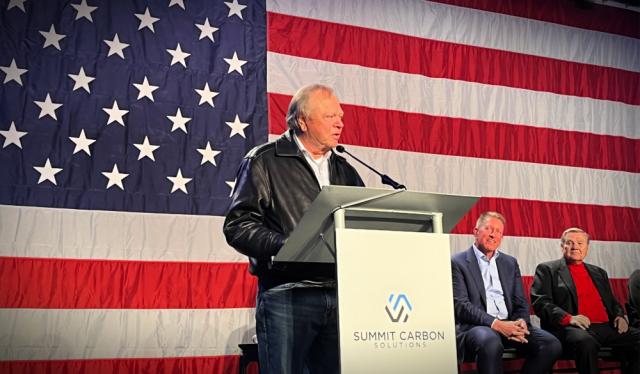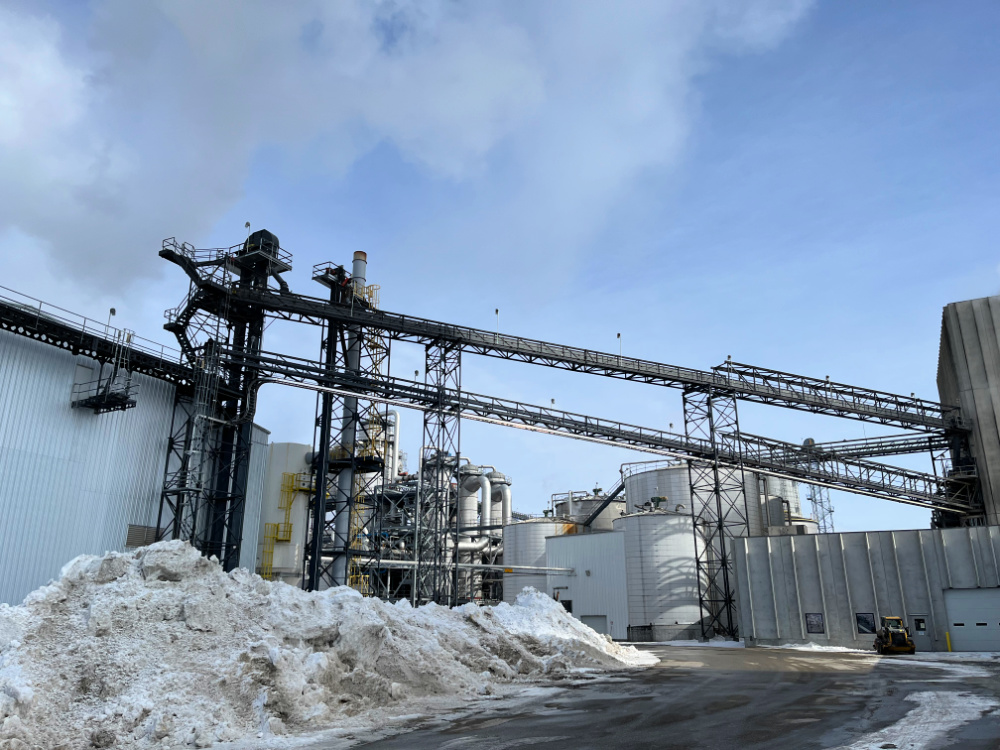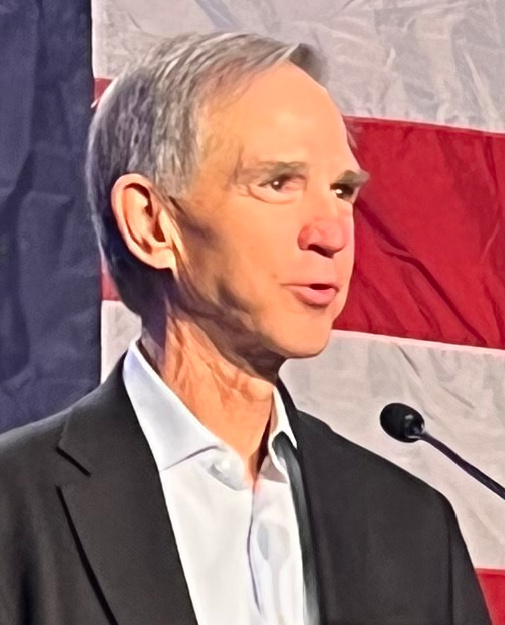
Continental Resources founder and chairman Harold Hamm addresses a crowd at Theraldson Ethanol, where Continental announced a $250 million investment in Summit Carbon Solutions’ carbon sequestration project. (Source: Brian Walzel / Hart Energy)
Presented by:
FARGO, N.D.—Continental Resources Inc. unveiled a $250 million investment into a carbon capture and sequestration project in the Williston Basin on March 2 that its partners say, once in operation, will be the largest such carbon sequestration project in the world.
The Williston Basin, from which Continental has been producing for more than five decades, has the ideal properties for long-term carbon storage, according to founder and chairman Harold Hamm.
“[The Williston] has sandstone, and we’ve talked about the thickness of it, its consistency, its good permeability, and good properties so that injectability is good,” Hamm told Hart Energy. “It’s better than a mile deep, it has good caprock above [the reservoir] that’s going to keep the carbon in place. All of those things add up, and this has been through quite a process from a geological engineering perspective.”
Hamm spoke at an event announcing the project on March 2 alongside the group leading the project, Summit Carbon Solutions, a portfolio company of Summit Agricultural Group. On hand were Continental CEO Billy Berry, North Dakota Governor Doug Burgum, Summit Agriculture Group CEO Bruce Rastetter and Theraldson Ethanol founder Gary Theraldson.
Summit Carbon Solutions will primarily capture CO₂ from ethanol plants and other industrial sources in Iowa, Nebraska, Minnesota, North Dakota and South Dakota. According to Summit, the CO₂ will be aggregated and transported to North Dakota via pipeline, where it will be sequestered in subsurface geologic formations. Those formations will be in the Williston Basin, where Continental Resources has been the leading producer for more than 50 years.
“We think about where we should be taking this company, where should we go next, and we have had a lot of different strategic discussions about what the things we should be focused on, what are the things we should invest in, and there are some tenets that come from what makes sense for a company like Continental,” Berry said during the event held at Theraldson Ethanol, one of the 31 ethanol plants enlisted to offload its carbon to Summit.
“We should play to our strengths and play to our core competencies.”

Berry called the Summit carbon capture project a “paragon of excellence for carbon capture structure.”
“I think this is a model that every government entity in the world should be looking to replicate,” he said.
According to Summit, the 31 ethanol facilities will deliver more than 8 million metric tons per annum (MMmtpa) of CO₂ with initial pipeline capacity of 12 MMmtpa and expansion capabilities to handle up to 20 MMmtpa.
Rastetter said that beyond the initial 31 ethanol plants, his group is working to secure commitments from other high CO₂ emitters in the Upper Midwest, such as coke and fertilizer facilities.

“This project will cut ethanol’s carbon score in half,” he said. “And with the improvements that are going on in agriculture that we all know which leads to increased yields, less nitrogen yields, and producing more with less and with greater sustainability, that’s how plants have a long-term opportunity at net-zero carbon.”
Berry said that Continental’s first investment in a CO₂ sequestration project such as Summit’s aligned with both the company’s long-term vision, and the desires of its shareholders and investors.
“We’re in the liquid fuel business, and the byproduct of liquid fuel is greenhouse gas, and greenhouse-gas needs to be mitigated. We’re all looking at what we can do to decrease carbon intensity,” he said. “So, it was easy for us to say this is a project where we can invest our efforts to continue to reduce greenhouse gas. Our company is down 40% on greenhouse gas [emissions] since 2016, so this is just a continued effort on our part to go out and do the right thing. It’s the right project at the right time with the right partners and the right government support.”
Burgum explained that the Summit project is just the latest in carbon management efforts his state has supported, having been one of the first states in the country to capture and transport CO₂.
“We’ve been capturing CO₂ in North Dakota since the 1980s and putting it in pipelines and shipping it up to Canada,” he said. “So, we know a little bit about CO₂ in North Dakota, but this is going to be the largest [project] of its kind. This project has the potential to capture and permanently store over 12 billion tons of carbon dioxide across that 2,000-mile pipeline. That’s like taking 2.6 million cars off the road.”
To help facilitate a project like Summit’s, Burgum explained that North Dakota has worked over the past several years to earn primacy over carbon injection wells, or Class 6 wells.
“Anybody who knows anything about building a pipeline know that it’s gotten so political, [it matters] who is in the White House with an executive order,” Burgum said. “If you’re [Rastetter] and you are trying to raise capital for a project and you can’t tell your investors that you’re going to be able to get a permit or not, it’s pretty hard to raise capital. [Rastetter] knows that if he follows all the rules in North Dakota, and we’ve got extensive rules, just as Harold [Hamm] knows, we’ve got a great regulatory environment for oil and gas, and we’ve got some of the cleanest air and cleanest water in the country.”
Jeff Hume, Continental vice chairman of strategic growth initiatives, added that the sequestration reservoir holds large quantities of saline water and is more than 300 feet thick with 25% porosity
“We’re on the eastern side of the Williston Basin, so away from oil and gas activity,” he said. “That puts us away from existing wells, so we have minimal amount of penetration out here. We’ve got a very good control on the sandstone that has been drilled, 3D seismic has been shot. [Rastetter’s] team is even seeing a little bit better reservoir thickness than we thought from the seismic. They’re drilling test wells now and getting samples cores from that.”
Theraldson Ethanol was founded by Gary Theraldson, who made his fortune as a hotelier, eventually accumulating more than 350 properties in his career, selling nearly half of them to Goldman Sachs for $1.2 billion. He founded the ethanol facility in 2008, which produces 150 million gallons of ethanol annually.
As Berry explained, ethanol traditionally emits a high concentration of CO₂ during processing from corn to liquid fuel.
“Where do you go after the CO₂?” Berry said. “It’s the high-concentration, low-cost capture, and ethanol plants fit that.”
Hume said projects such as the one being led by Summit are the fastest way to lower the carbon score of an ethanol plant. He added that fertilizer plants that are looking to offload their CO₂ could experience repeat valuation.
“If your fertilizer plant gets decarbonized, and the fertilizer goes back in the ground, that’s fertilizing the corn, then that corn that’s coming in the plant’s got a lower [carbon] score, then that lowers the score even more,” he said. “So, there’s a virtual cycle the way the carbon scores go if you can decarbonize the inputs into the growers.”
Rastetter said the Summit sequestration should be underway by the spring of 2024.
“We are in the process of permitting about 2,000 miles of pipeline, and doing all the engineering work both at the plants and with the compression equipment, and then the pipeline, bidding the pipeline project to four or five companies, and are actively engaged in signing up landowners on the carbon sequestration side west of Bismarck,” he said.
Rastetter said more than 90% of landowners potentially impacted by pipelines and injection wells have signed up for the project, representing about 150,000 acres in the area.

